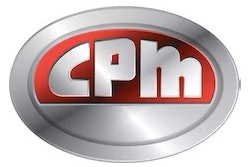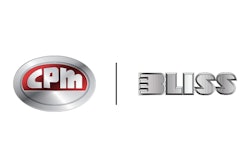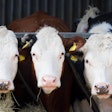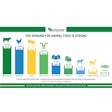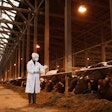Driven by the growing needs of its producer partners, Iowa’s NEW Cooperative created its NEW Feeds, LCC, feed division in the early 90s. As technology, regulations and automation shaped the feed manufacturing industry, Elwyn Bruhl, feed division manager and 40-year NEW Cooperative employee, has witnessed every stage of this evolution. Standing within the cooperative’s new state-of-the-art Liddendale, IA, feed mill, Bruhl smiles and confidently reports: “This isn’t your daddy’s feed mill.”
“With the support of the board and upper management, the feed division has grown from producing 20,000 tons a year to an operation delivering 750,000-tons of feed annually,” Bruhl notes.
In the late 2000s, Iowa saw a major expansion of the hog population [stats from 97]. According to the Iowa State University Extension’s Iowa Farm Outlook (July 2011), the trend continues as Iowa’s inventory of market hogs increased nearly 5% in 2011. The state’s total swine inventory is now approaching 19 million head.
“Our customer base has shifted from the traditional to commercial businesses." Bruhl explains. "Large companies have fueled the growth of the livestock and feed industry by built economies of scale [in Iowa].”
As the need for feed milling capacity grew, NEW Cooperative was prepared to capitalize on the boom with its feed mills in Bode, Palmer and Duncombe, IA. NEW Feeds, LLC, is the result of a joint venture with Land O’ Lakes, which claims a 25% stake in the ownership of its assets.
“We were at capacity at the other mills,” Bruhl says. “If we were to continue our growth, we needed to expand our territory. The organization chose Lidderdale because we already had grain and agronomy locations in the area — not to mention the size of the existing livestock population.”
NEW Cooperative, Inc., a member-owned, agriculture cooperative servicing 21 operating locations throughout the northwest region of Iowa, seized the growth potential opportunities a feed mill in close proximity to its grain elevator offers.
New marketing opportunity
NEW Cooperative's grain elevators in Glidden, Lidderdale and Lanesburrow handle 7 million bushels of corn, and 2 million bushels of beans, annually. Rail service left the area in the 70s, leaving trucking as the only way to transfer grain to a rail site or ethanol plant. The half way point between the other grain facilities, Lidderdale, was the obvious location to build a new feed mill — but also a strategic decision driven by the desire to introduce an additional market for the co-op’s corn.
For the 750,000 tons of feed NEW Cooperative produces, it puts in 18 to 22 bushels of corn into every ton — averaging out to 14 million bushels of corn that accounts for 25% of its annual corn receipts.
While it may be at a set margin — and not at the price NEW Cooperative's grain department could make selling it — but, as Bruhl explains, reducing the handling and trucking of the corn is a significant cost reduction.
“Saving in extra handling and transportation of the corn sits around 10 cents for transportation, 4 cents for elevating a bushel,” Bruhl explains. "At savings of 14 cents/bushel — added to the margin we’re getting from the corn on the lift — we’re doing alright."
After eight months of research and planning on the co-ops part, Younglove LLC began construction of the $6 million concrete [slip form?] feed mill began in late 2009. The mill became operational in mid-July 2010, starting small, operating 12 hours a day.
Efficiently making feed
The process begins as truck drivers enter the office before the dump to ensure operators are matching the correct truck with the corresponding load number. Drivers dropping off purchased major ingredients — soy meal, bakery [goods?], DDGS, wheat [meds?] — gain approval from the mill, and are directed to proper receiving pit. The unloaded ingredients are stored in a bin until the ration calls for it; the mill keeps a running inventory of product and reorders only when necessary. Inventory is turned once a day on all products; 1,000 tons of ingredients move among 900 tons of overhead ingredient bin storage space. Corn, however, is delivered directly from the steel storage bins via a [Brand - Intersystems?] conveyor, and into the [Brand] hopper before being fed to one of two roller mills.
The mill is completely automated using WEM’s 4000 Series Batching System for routing in receiving and mixing system load out, load out, and from receiving to storage. Feed Management Systems’ software controls the billing at location and puts feed order into system before WEM manufactures the feed. Fiscal and computer inventories are kept for comparison.
[#?] employees work in the mill.
“If we look at how the feed industry has changed, it used to be we had a few guys in the feed mill and you were lucky if produced 100 ton/day,” Bruhl notes. “Now, you have a couple of guys in the mill and they produce 1,000 ton/day on a long shift.”
--- WORKFLOW FOLLOW-UP ---
Ingredients move from receiving to bin, then to the weigh hopper, the mixer and the surge — once mixed routed into load out.
• Scott 4-ton twin shaft mixer for a better, faster mix
• Put in RMS roller mill and a Rothscamp Champion roller mill – same size 12X52 — tracking the energy usage and put electrical equipment in place to track ampage and look at cost of what it takes to take corn from 700 to 500 microns to maintain CVs. Not working yet. Extensive comparisons there to see which roller mill has fewer repairs and energy usage
To help with convenience and labor savings the facility has a liquid fat and a lysine tank, “a blessing” because it allows room for other ingredients the microsystem. Liquids are automated applying 90 gallons/minute and 102 pounds per ton of fat. [exiting diets and are being replaced by DDGS??]
• Finish feed cleaner
• 9 load outs
• 19 micro units
• Minor and major scale to batch faster
• No scale for load out that the truck drives onto. Stationary 6-ton scale overhead loaded directing into truck saved $$ there. 6-ton stationary load out scale to weigh outgoing feed product.
The facility produces and delivers 100% swine feed — from sows to finish pigs — to four major customers and 20 traditional farmer customers within a 20-mile radius.
“We’re walking before we run,” Bruhl explains. “We brought tonnage on slowly and after two months started slamming more tons in and running 20,000 to 22,000 a month. Currently we’re on pace to manufacture 240,000 tons/annually. We hope to get to the 300,000 mark after we builds our base in the area.”
The mill’s annual production capacity is estimated to be 370,000 tons. “We can do another 100,000 ton no problem, but we need more transportation so it will be brought on incrementally,” he explains.
Lean thinking = $$
The cost-conscious team creatively cut back in certain areas without sacrificing functionality. For example, it installed smaller bins and fewer load outs that were still capable of handling 80 tons/hour when properly managed. It also cut the warehouse footprint down to avoid carrying excess inventory.
“We have good people coordinating receiving and materials, and managing the inventory,” Bruhl says. “It helps that we have a ready supply of corn available from the elevator’s steel tanks that deliver right into the mill.”
The new feed mill’s specified equipment was selected based on the proven performance demonstrated in the cooperative’s other facilities.
The feed division is also using the new mill in conducting an experiment by installing two roller mills — a CPM [model name/#] and a RSM [model name/#] — in an effort to track the efficiency and energy saving before it purchases new equipment for future upgrades.
“We are compiling data and energy consumption statistics using Emon Demon to usage and amps to ensure the mills are pulling their weight,” Bruhl explains. Additionally, the NEW Feeds staff is collecting micron samples numerous times in a day.
Bruhl says: “Throughput and cost control are the name of the game. Margins are slim and we need to be efficient in what we’re doing to make money for the member owners who do not buy the feed. One of our customers said we’re too high – we’re a factory making feed, how many factories do you see operating at a loss today that still exist today? We have to make money to keep the business going, keep quality in place, and deliver an ROI for our customers.”
Safe feed a high priority
Formulations are customer driven: large customers have their own, but the cooperative provides traditional producers with what they need for their rations. Bulk tote bags [How many? More about this...] each hold a ton with vitamin trace minerals for integrator customers or put into the micro bin system, and is then dumped and replaced when empty.
One of the main goals of the new facility is to deliver safe, quality feed. Bruhl looked to tightening safe food/safe feed regulations and adjusted the sites security and production methods accordingly.
“Regulations will continue to become more stringent for the feed industry,” he says. “We are very careful in terms of traceability and keep a watchful eye on perimeter with security camera prevent anyone from trying to tamper with our product.”
The mill is especially cognizant of cross contamination concerns, flushing truck and mixers religiously after each batch to prevent unwelcome drug residues out of the meat heading to export markets.
Bruhl explains, noting feed is tracked to the load out bin to make sure no withdrawal drug is added on top of another feed: “We have a lot at stake. The feed mill becomes another source for the grain – add the transportation and elevation savings to the margin feds back into company.”
NEW Cooperative strives to keep its employees educated on the changing regulations so they “can better understand the needs of [its] customer and what the FDA required them.”


